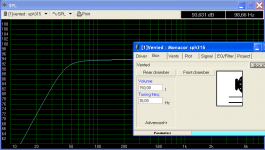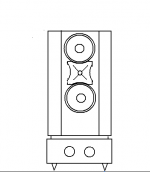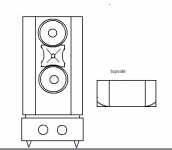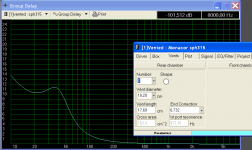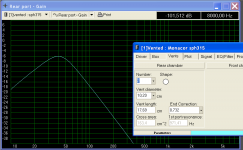With the fatial pro-horn driver you get 110dB down to 500Hz with one Watt. And is one of the lowest priced 1,4" HF drivers what do you want more.
I like the jmlc because I like the round horn dispersion to prevent coloration.
What many do not see is that it is the reason why for hifi use you can cross it very low because the driver does not see more then 1 Watt in normal use.
If you what to got to higher sound-pressure you have to measure the distortion at that sound-pressure to see if the HF-driver can do that with low XO.
I like the jmlc because I like the round horn dispersion to prevent coloration.
What many do not see is that it is the reason why for hifi use you can cross it very low because the driver does not see more then 1 Watt in normal use.
If you what to got to higher sound-pressure you have to measure the distortion at that sound-pressure to see if the HF-driver can do that with low XO.
Last edited:
Sorry Helmuth. I didn't notice your two later posts before I replied.
That Faithal Pro driver looks good, pretty straight performance down to below 500Hz. Amazing.
Interesting thought you have on this BR-box. -6dB @ 40Hz is probably not that bad, even though everybody is talking about 20Hz My goodness; 98-99dB 1Wmtr -6dB 40Hz. I'm used to some old Quad ESL63s, and some cheap modern 2way compacts. This would be a dramatic change. I'm enthusiastic.
My goodness; 98-99dB 1Wmtr -6dB 40Hz. I'm used to some old Quad ESL63s, and some cheap modern 2way compacts. This would be a dramatic change. I'm enthusiastic.
Thanks Helmuth.
Hm, will I sleep tonight?
Anyway, have a good night!
That Faithal Pro driver looks good, pretty straight performance down to below 500Hz. Amazing.
Interesting thought you have on this BR-box. -6dB @ 40Hz is probably not that bad, even though everybody is talking about 20Hz
Thanks Helmuth.
Hm, will I sleep tonight?
Anyway, have a good night!
Recommended 15" because of low Fs and low price and good price performance. And big x-max
Beyma sm115k.
http://profesional.beyma.com/pdf/SM-115%20KE.pdf
Also the 18" is very nice sm118.
http://profesional.beyma.com/pdf/SM-118%20NE.pdf
15" oberton
http://www.oberton.com/index.php?option=com_content&view=article&id=167%3A15b500&catid=49%3Aferrite-loudspeakers
Beyma sm115k.
http://profesional.beyma.com/pdf/SM-115%20KE.pdf
Also the 18" is very nice sm118.
http://profesional.beyma.com/pdf/SM-118%20NE.pdf
15" oberton
http://www.oberton.com/index.php?option=com_content&view=article&id=167%3A15b500&catid=49%3Aferrite-loudspeakers
Last edited:
I couldn't sleep, obviously. Thanks again Helmuth.
Regarding the Beymas, and oberton Are you thinking Vented box? I've noticed that Mr Tangen is using Beymas for his big Open H-baffles, and uses a lot of eq to compensate for low Qts / low end drop. BTW, I've noticed the Beymas mentioned in some treads here at the forum.
Do you have any thoughts on the eliptical Faital Pro horn, for 1,4" throat? It could give a relatively compact system.
Well well. Right now I feel for plunging into it.
Good night again
Regarding the Beymas, and oberton Are you thinking Vented box? I've noticed that Mr Tangen is using Beymas for his big Open H-baffles, and uses a lot of eq to compensate for low Qts / low end drop. BTW, I've noticed the Beymas mentioned in some treads here at the forum.
Do you have any thoughts on the eliptical Faital Pro horn, for 1,4" throat? It could give a relatively compact system.
Well well. Right now I feel for plunging into it.
Good night again
I couldn't sleep, obviously. Thanks again Helmuth.
Regarding the Beymas, and oberton Are you thinking Vented box? I've noticed that Mr Tangen is using Beymas for his big Open H-baffles, and uses a lot of eq to compensate for low Qts / low end drop. BTW, I've noticed the Beymas mentioned in some treads here at the forum.
Do you have any thoughts on the eliptical Faital Pro horn, for 1,4" throat? It could give a relatively compact system.
Well well. Right now I feel for plunging into it.
Good night again
The 15" or 18" is for OB. BR would make a big Box.
High efficient 12" BR monacor sph315. Grey line 94dB 1wmtr polypropylene cone. and inexpensive. Low groupdelay low thd. Small box.
-6dB 30Hz.
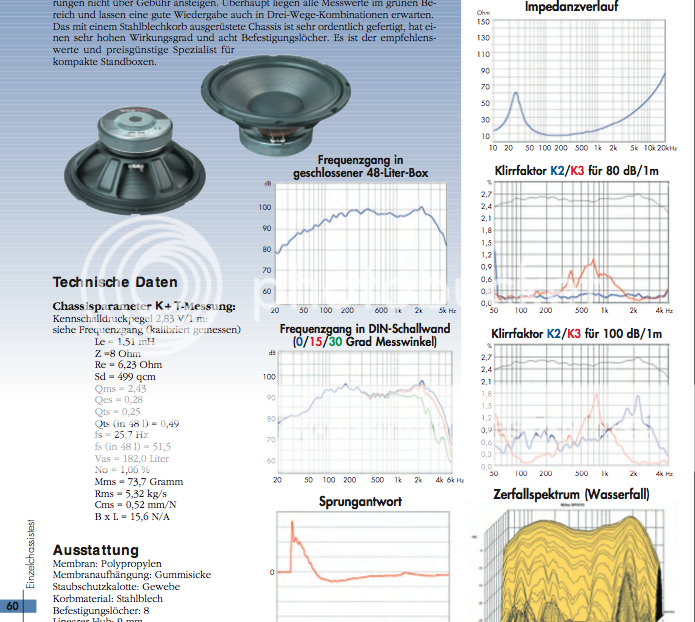
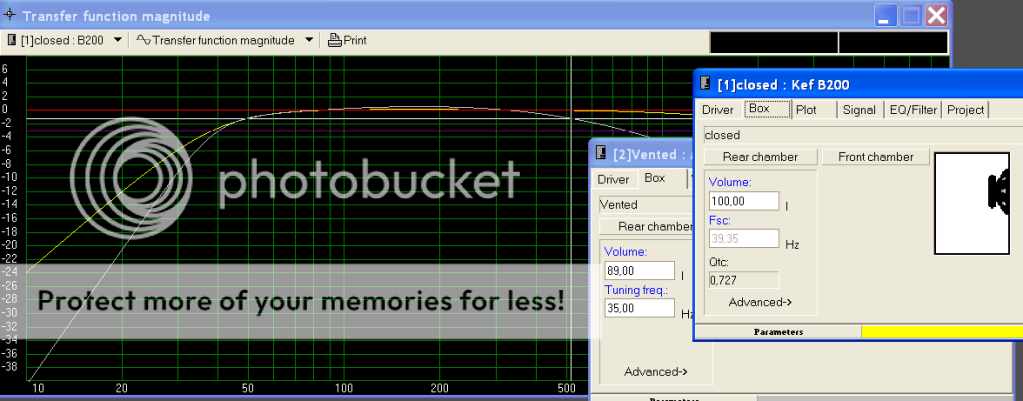
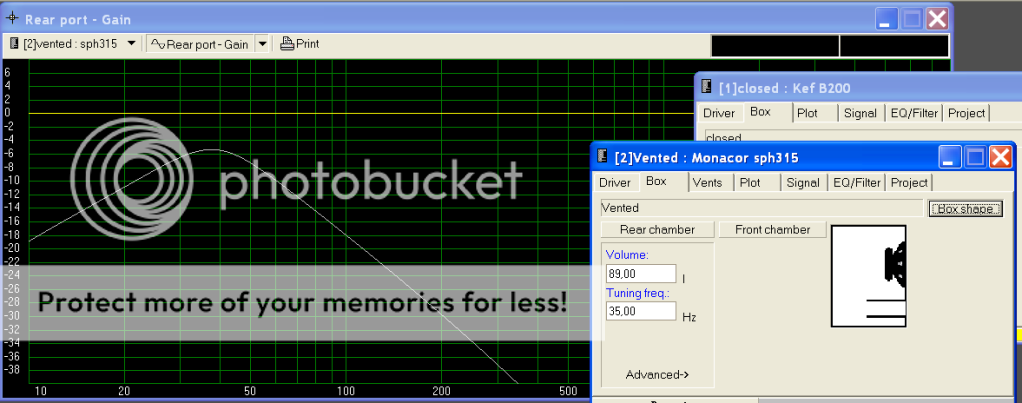
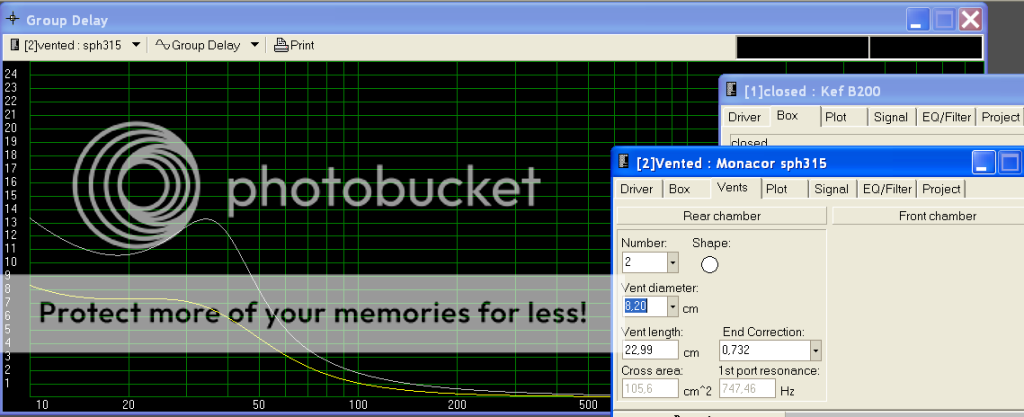
I have no exspirience with fatial pro looks nice and very compatative price. The horn is big and ugly. It would look better on its side in a hifi speaker dispersion is good enough.
Last edited:
You are right. The Faital Pro horn is quite big, about the same size as the Iwata 600.
Thanks a lot for all your simulations. What simulation-program are you using?
The Monacor looks quite nice in your simulations, and at a very good price
Seems like the German measurements differs a bit from Monacors own data. Probably very helpful when designing a vented box. Is from a German magazine? If so, it must be quite dedicated to diy-hifi. The BR-peak at around 35Hz is probably deep enough for me. And probably a lot deeper than many of the typical two-way "stick"-speakers on the market.
It would be nice though to achieve a better efficiency. I could for instance use two of the Monacors. As the cabinet is so small I could easily double it. 85L gives for instance a cube with 3 x 0,44m sides.
The benefit of the wented box, is that I can place it close to the front wall of my listening room. The OB-bass need space witch is a bit difficult for the moment.
I could imagine a box WxHxD @ 0,65m x 0,9m x 0,35. The depth may be increased. Anyway, if this was the internal volume, the volume would be around 200L.
PHL-audio had got some 15" speakers with, according to their own data, relatively high efficiency, and good bass in relatively small cabinets: For instance this one: PHL AUDIO - Parameters : 5010 I dont know the price here. Probably not cheap.
But with near 200L on hand, I could probably use some of the Beymas you mentioned.
Thanks a lot for all your simulations. What simulation-program are you using?
The Monacor looks quite nice in your simulations, and at a very good price
Seems like the German measurements differs a bit from Monacors own data. Probably very helpful when designing a vented box. Is from a German magazine? If so, it must be quite dedicated to diy-hifi. The BR-peak at around 35Hz is probably deep enough for me. And probably a lot deeper than many of the typical two-way "stick"-speakers on the market.
It would be nice though to achieve a better efficiency. I could for instance use two of the Monacors. As the cabinet is so small I could easily double it. 85L gives for instance a cube with 3 x 0,44m sides.
The benefit of the wented box, is that I can place it close to the front wall of my listening room. The OB-bass need space witch is a bit difficult for the moment.
I could imagine a box WxHxD @ 0,65m x 0,9m x 0,35. The depth may be increased. Anyway, if this was the internal volume, the volume would be around 200L.
PHL-audio had got some 15" speakers with, according to their own data, relatively high efficiency, and good bass in relatively small cabinets: For instance this one: PHL AUDIO - Parameters : 5010 I dont know the price here. Probably not cheap.
But with near 200L on hand, I could probably use some of the Beymas you mentioned.
Software I use.
Loudspeaker:
Speak
Telstra BigBlog -
LinearTeam
www.selfmadehifi.de
Boxsim - Homepage
www.jensen-onken.narod.ru/programs/ok.xls
mh-audio.nl - Home
Download Section
Home of the Edge
Electronic circuits.
http://www.simetrix.co.uk/sit.e/demo.html
PSUD2
Schematics printedcircuitboard
Free EAGLE PCB Design Software, Layout Software - CadSoft Freeware
Measure loudspeaker
ARTA Home
HOLM Acoustics
Drawing 3D model.
SketchUp
Visualisation CTC spacing.
Math, Physics, and Engineering Applets
Background sound reproduction
Forum zur Mikrofonaufnahme und Tonstudiotechnik ♪♫♪ Audio Tontechnik Eberhard Sengpiel - sengpielaudio = sengspielaudio und Sengpiel ist Sengspiel ebs Elektro-Akustik Audio Ausbildung Lehre Studio Tips Tipps Mikrofone Tonaufnahme Be
Background filter
Stored_energy_1
Stored_energy_2
Research resonance enclosure
HSI :: Luidspreker kast materialen onderzoek
Background dipole and sound reproduction
Linkwitz Lab - Loudspeaker Design
Loudspeaker:
Speak
Telstra BigBlog -
LinearTeam
www.selfmadehifi.de
Boxsim - Homepage
www.jensen-onken.narod.ru/programs/ok.xls
mh-audio.nl - Home
Download Section
Home of the Edge
Electronic circuits.
http://www.simetrix.co.uk/sit.e/demo.html
PSUD2
Schematics printedcircuitboard
Free EAGLE PCB Design Software, Layout Software - CadSoft Freeware
Measure loudspeaker
ARTA Home
HOLM Acoustics
Drawing 3D model.
SketchUp
Visualisation CTC spacing.
Math, Physics, and Engineering Applets
Background sound reproduction
Forum zur Mikrofonaufnahme und Tonstudiotechnik ♪♫♪ Audio Tontechnik Eberhard Sengpiel - sengpielaudio = sengspielaudio und Sengpiel ist Sengspiel ebs Elektro-Akustik Audio Ausbildung Lehre Studio Tips Tipps Mikrofone Tonaufnahme Be
Background filter
Stored_energy_1
Stored_energy_2
Research resonance enclosure
HSI :: Luidspreker kast materialen onderzoek
Background dipole and sound reproduction
Linkwitz Lab - Loudspeaker Design
monacor data is crappy as also for the lack of production quality, they have a big program and nice price woofers.The Monacor looks quite nice in your simulations, and at a very good price
Seems like the German measurements differs a bit from Monacors own data.
It would be nice though to achieve a better efficiency. I could for instance use two of the Monacors. As the cabinet is so small I could easily double it. 85L gives for instance a cube with 3 x 0,44m sides.
The benefit of the wented box, is that I can place it close to the front wall of my listening room.
I think you do good thinking there. Placing the box on wall will make it radiating halfspace and there for become constant directivity. And 3dB gain.
Two woofers wil not gain because the impedance is become lower. You will gain better distortion behavior.
I already had these same Ideas that is why I am so fast, I did search all ways to gain efficiency and keep it small.
Here the on wall wide baffle d'appolito horn project with 2X SPH315. 150 liter = 130liter with damping .
Horn RCF-h66 this is a fine horn because it helps reducing CTC spacing. It is qaulity made of aluminium short for no colaration of sound.
RCF - HF66
An externally hosted image should be here but it was not working when we last tested it.
The horn driver the fatial pro .
FaitalPRO - Professional Loudspeakers Made in Italy
An externally hosted image should be here but it was not working when we last tested it.
Attachments
Last edited:
15MB606 - Very High Output MB Ferrite Driver
7 cubic feet, tuning freq. 28 Hz, target 97 db for baffle step. Blue Music (Germany) has them for 144 Euros.
ND1460A - HF Neodymium Driver
Better than the Faital Pro. More compliant suspension with lower distortion at lower freq.s as a result. MUCH easier impedance to work with (..results in less complex and expensive crossover). Down-side is top octave extension breaks-up a little lower than titanium (..but still in the top octave). Less expensive (..320 US at Loudspeakers Plus vs 339 Euros at Blue Music..)
For an MTM look to Paul W's Raptors..
While a narrow dispersion pattern horn like the Faital and the Raptors use allows for a lower freq. "cut-off" (with a smaller horn), I'd suggest looking at other designs with wider horizontal dispersion, at least up to about 2-3 kHz. It's too bad the SEOS 18 wasn't designed for a 1.4" exit. I'd probably ask Autotech for a re-design with that in mind.
7 cubic feet, tuning freq. 28 Hz, target 97 db for baffle step. Blue Music (Germany) has them for 144 Euros.
ND1460A - HF Neodymium Driver
Better than the Faital Pro. More compliant suspension with lower distortion at lower freq.s as a result. MUCH easier impedance to work with (..results in less complex and expensive crossover). Down-side is top octave extension breaks-up a little lower than titanium (..but still in the top octave). Less expensive (..320 US at Loudspeakers Plus vs 339 Euros at Blue Music..)
For an MTM look to Paul W's Raptors..
While a narrow dispersion pattern horn like the Faital and the Raptors use allows for a lower freq. "cut-off" (with a smaller horn), I'd suggest looking at other designs with wider horizontal dispersion, at least up to about 2-3 kHz. It's too bad the SEOS 18 wasn't designed for a 1.4" exit. I'd probably ask Autotech for a re-design with that in mind.
Last edited:
Dammit Helmuth, that's a lot of different programs and alculators. Thank you very much.
MTM's aren't they beaming, meaning you are not "allowed" to sink down in the chair? I think I would stack the woofers below the horn.
I guess you have performed quite a lot of design-studies
ScotG: Thank you for your input. I guess you are aiming at the impedance hump at, say 17 ohm, around 1800Hz for the Faital. I'm not smart enough, or informed enough, to understand the consequences of this hump. But there is probably some kind of resonance phenomenon somewhere in the system at this frequency. Anyway, I don't think some unevenness in the other end of the scale would cause much problem, as Im soon 50 years old. And I've noticed that my mothers old dog have much better ears than me. But he doesn't understand music
Regarding the SEOS and other oblate spheroids. I've been sceptic about them because of the relatively sharp "radius" in the throat. And I think their curves just look odd. So I would probably go for a leCleach-type or traxtric horn. But I have to admit, this is just mental ideas. I haven't listened to any of them. BTW I've had my eyes on the Iwata 600 from Autotech. What I liked with the Faital Pro is that it may be integrated in the woofer-cabinet. The transition from horn to cabinet looks smooth and round. It's traxtric. But the Iwata 600 got a bit wider dispersion. And yes, I guess the faital is a bit narrow, although I not trained to evaluate these dispersion graps.
I must say, there are many choices to make. And I guess there is no obvious answer. I'm not even sure about what I want. I've been looking around for some hifi speakers for a while. And I feel that most of them sounds like music from a box. There may be some impressive aspects, but the sum doesn't ad up something that resembles a sound-stage. Simple two-way speakers with one 6,5" midwoofer, and a 1" tweeter are hyped by the hifi-press and sold at insane prices. A friend of mine bought some pretty expensive Avantgarde horn-systems. And there it was something. The music was all over the place, and not something anaemic struggling to reach you from inside a cramped box. So here I am. Drodling about OB-bass, horns, Qts and other things I can't say I understand. Well well, life is a game. And hopefully I'll become good enough at this particular game to make myself some satisfying speakers.
Cheers
MTM's aren't they beaming, meaning you are not "allowed" to sink down in the chair? I think I would stack the woofers below the horn.
I guess you have performed quite a lot of design-studies
ScotG: Thank you for your input. I guess you are aiming at the impedance hump at, say 17 ohm, around 1800Hz for the Faital. I'm not smart enough, or informed enough, to understand the consequences of this hump. But there is probably some kind of resonance phenomenon somewhere in the system at this frequency. Anyway, I don't think some unevenness in the other end of the scale would cause much problem, as Im soon 50 years old. And I've noticed that my mothers old dog have much better ears than me. But he doesn't understand music
Regarding the SEOS and other oblate spheroids. I've been sceptic about them because of the relatively sharp "radius" in the throat. And I think their curves just look odd. So I would probably go for a leCleach-type or traxtric horn. But I have to admit, this is just mental ideas. I haven't listened to any of them. BTW I've had my eyes on the Iwata 600 from Autotech. What I liked with the Faital Pro is that it may be integrated in the woofer-cabinet. The transition from horn to cabinet looks smooth and round. It's traxtric. But the Iwata 600 got a bit wider dispersion. And yes, I guess the faital is a bit narrow, although I not trained to evaluate these dispersion graps.
I must say, there are many choices to make. And I guess there is no obvious answer. I'm not even sure about what I want. I've been looking around for some hifi speakers for a while. And I feel that most of them sounds like music from a box. There may be some impressive aspects, but the sum doesn't ad up something that resembles a sound-stage. Simple two-way speakers with one 6,5" midwoofer, and a 1" tweeter are hyped by the hifi-press and sold at insane prices. A friend of mine bought some pretty expensive Avantgarde horn-systems. And there it was something. The music was all over the place, and not something anaemic struggling to reach you from inside a cramped box. So here I am. Drodling about OB-bass, horns, Qts and other things I can't say I understand. Well well, life is a game. And hopefully I'll become good enough at this particular game to make myself some satisfying speakers.
Cheers
BTW Helmuth, regarding the efficiency with two woofers. I was starting to set up an equation for you, just to make you understand that there will be a gain in efficiency when a parallel woofer is added. But then it became clear to me that this is not the case. The only thing that matters is the current that goes through the voice-coil. I've read so many times that there is a gain when doubling the amount of speakers. Hypnosis.
MTM's aren't they beaming, meaning you are not "allowed" to sink down in the chair? I think I would stack the woofers below the horn.
I not trained to evaluate these dispersion graps.
Beaming or not to beaming thats the question.
My horn beams at higher frequencys. Is that a problem:No
Maybe it is even a advantage not to receive reflections of ceiling and walls.
With the BHB I want to create a point source.
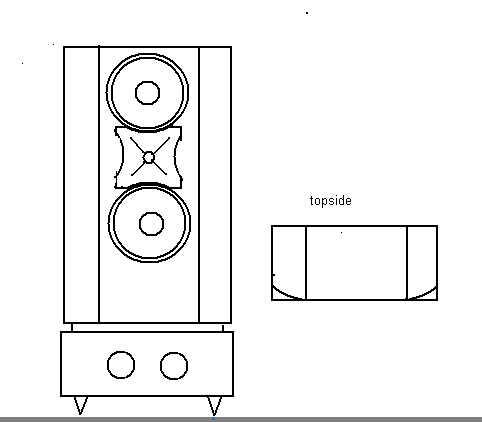
Within the wave length of the XO frequency. The RCF horn HF66 has a dispersion of 60degrees X 60degrees.
This means on 3mtr distance you have 3,4mtr wide dipersion more then enough.
I read of others how say 40 degrees is enough or a 40X60 horn is perfect.
About dispersion:
Can you hear dispersion when you sit down stereo position: no
Can you hear the reflections of dispersion: yes
Do you want that : I think no.
What we need is controlled dispersion over bandwidth. That is the challenge to have the same sound quality on each distance.
Last edited:
BTW Helmuth, regarding the efficiency with two woofers. I was starting to set up an equation for you, just to make you understand that there will be a gain in efficiency when a parallel woofer is added. But then it became clear to me that this is not the case. The only thing that matters is the current that goes through the voice-coil. I've read so many times that there is a gain when doubling the amount of speakers. Hypnosis.
This is a nice paper to let you understand the gain and CTC spacing.
http://audioroundtable.com/misc/nflawp.pdf
Attachments
About dispersion:
Can you hear dispersion: no
Buzzzz. Wrong answer.
You can most certainly hear dispersion, in fact perceptually the dispersion pattern is generally far more prevalent than reflections from most room boundaries - at least at higher freq.s..
The Ted Jordan technique for "crossing the loudspeaker 0 degree axis in front of the listener" to achieve a more stable center image relies on a loss in pressure at higher freq.s for the *closer* loudspeaker (to the listener) specifically due to the dispersion pattern. (..this is the same method that Earl recommends for his Gedlee loudspeakers.)
When you really narrow/lower the dispersion pattern you'll end-up with sound that seems to be coming from next to you, like someone talking at your side or even in your ear. Totally isolate it with high suppression headphones and the sound goes even "further" - as if playing in your scull.
Buzzzz. Wrong answer.
You can most certainly hear dispersion, in fact perceptually the dispersion
How can I hear the dispersion witch doesn't come to my ears?
Only the one's who comeback from the wall I will hear, is my visualization. I do not understand the point you are making.
There are many things to think about 
Regarding the dispersion: Intuitively Helmuts approach sounds right to me, but off course; I could be wrong At least the concept is easier to understand. Isn't recorded music often mixed relative to the sound of some near field monitors?
At least the concept is easier to understand. Isn't recorded music often mixed relative to the sound of some near field monitors?
Theories or not, in the end what you prefer is what counts. Some like to have the sweet-spot between their ears, and some want it a bit in the front.
Maybe narrow dispersion was what i experienced on my friends Avantgarde system? An other friend of mine bought a new house with a huge living-room. So his IMF reference transmissionline speakers went further away from the listening position, leading to the impression of "music from a box". Somehow the music didn't fill the room. Of course, in this new setting, we were listening to more "dispersion" and less headphones compared to the previous more cramped living room. So there is probably a balance, and that balance isn't necessarily the same for everyone. The fun ting about it is that this subjectivity creates room for endless discussions in fora like this.
Regarding the dispersion: Intuitively Helmuts approach sounds right to me, but off course; I could be wrong
Theories or not, in the end what you prefer is what counts. Some like to have the sweet-spot between their ears, and some want it a bit in the front.
Maybe narrow dispersion was what i experienced on my friends Avantgarde system? An other friend of mine bought a new house with a huge living-room. So his IMF reference transmissionline speakers went further away from the listening position, leading to the impression of "music from a box". Somehow the music didn't fill the room. Of course, in this new setting, we were listening to more "dispersion" and less headphones compared to the previous more cramped living room. So there is probably a balance, and that balance isn't necessarily the same for everyone. The fun ting about it is that this subjectivity creates room for endless discussions in fora like this.
ScotG: Thank you for your input. I guess you are aiming at the impedance hump at, say 17 ohm, around 1800Hz for the Faital. I'm not smart enough, or informed enough, to understand the consequences of this hump. But there is probably some kind of resonance phenomenon somewhere in the system at this frequency. Anyway, I don't think some unevenness in the other end of the scale would cause much problem, as Im soon 50 years old. And I've noticed that my mothers old dog have much better ears than me. But he doesn't understand music
Regarding the SEOS and other oblate spheroids. I've been sceptic about them because of the relatively sharp "radius" in the throat. And I think their curves just look odd. So I would probably go for a leCleach-type or traxtric horn. But I have to admit, this is just mental ideas. I haven't listened to any of them. BTW I've had my eyes on the Iwata 600 from Autotech. What I liked with the Faital Pro is that it may be integrated in the woofer-cabinet. The transition from horn to cabinet looks smooth and round. It's traxtric. But the Iwata 600 got a bit wider dispersion. And yes, I guess the faital is a bit narrow, although I not trained to evaluate these dispersion graps.
I must say, there are many choices to make. And I guess there is no obvious answer. I'm not even sure about what I want. I've been looking around for some hifi speakers for a while. And I feel that most of them sounds like music from a box. There may be some impressive aspects, but the sum doesn't ad up something that resembles a sound-stage. Simple two-way speakers with one 6,5" midwoofer, and a 1" tweeter are hyped by the hifi-press and sold at insane prices. A friend of mine bought some pretty expensive Avantgarde horn-systems. And there it was something. The music was all over the place, and not something anaemic struggling to reach you from inside a cramped box. So here I am. Drodling about OB-bass, horns, Qts and other things I can't say I understand. Well well, life is a game. And hopefully I'll become good enough at this particular game to make myself some satisfying speakers.
Cheers
Impedance deviations can cause issues with the crossover, IF it's passive and/or you are using an amplifier with a "high" output impedance.
The freq. "curve" on more constant directivity design (..like the SEOS), can be handled fairly easily with the crossover design for a flat summed response - again though provided that Impedance isn't a problem.
It's also nicer to have a lower resonance that is further "away" from the crossover freq.. (..that 18 sound driver is lower than the primary resonance of the faital pro.)
There is of course the *question* of if you like a wider directivity or a narrower one, and how the overall dispersion pattern acts (..like narrowing at higher freq.s or not).
No one can really tell you what you're preference will be, it's just something you'll have to find out for yourself.
The diffraction from the fast "early" expansion at the front of an OS profile doesn't seem to be much of a problem, provided it's done well. Even the linear decay profiles for various axis don't seem to show many problems. Like overall dispersion however, you may prefer a slower initial diffraction/expansion like a Le Cleac'h profile provides. Again, something you'll have to figure out for yourself.
How can I hear the dispersion witch doesn't come to my ears?
Only the one's who comeback from the wall I will hear, is my visualization. I do not understand the point you are making.
Who said that an off-axis dispersion pattern doesn't come to your ears? It does. Even without reflections in the environment present (..the result of diffraction from the loudspeaker). Of course depending on the design the pressure difference from the average may be extreme, but usually even this doesn't occur until above 2 kHz or so - and even then with only a design that is very directive in the treble region.
Another aspect is that you have 2 ears. (..you do, don't you?
The point I'm trying to make is that you do hear dispersion (..which was contrary to your statement). Also, perceptually - most people "compensate" with respect to reflections. However really close proximity to a boundary (like a near wall) can make it more difficult to compensate. Said differently: it's not that most people can't hear the effect generated by reflections, but rather that after a bit of learning it doesn't seem to matter much. ("Grouping" intensity differences due to modes at lower freq.s would be an exception.)
In the context of loudspeaker design - dispersion is still quite important, because you do hear it.
In the context of a particular waveguide pattern (provided the transition to the next lower freq. driver is reasonably "continuous"), it's often a "matter of taste" to the particular individual. Some seem to love a narrow dispersion pattern waveguide, others may (and have) reacted negatively.
Last edited:
- Status
- This old topic is closed. If you want to reopen this topic, contact a moderator using the "Report Post" button.
- Home
- Loudspeakers
- Multi-Way
- photoshoot OB MK1, at least they sound good
